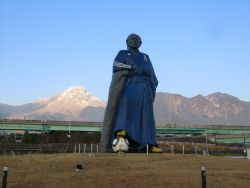
Originally published on metropolis.co.jp on December 2009

Many years ago, people scoffed at a news report describing how different Japanese snow was from foreign snow. Of course, now we have the internet to decide for us.
“Snowflakes… which fall in the form of a ball due to melting and refreezing, rather than a flake, are known as graupel,” says Wikipedia, the repository of all things we want to believe are true. As journalists are not allowed to believe Wikipedia, I checked with a true snow expert: moguls skier Miki Ito.
“If I ski in Hokkaido one day and in Hakuba the next day, it’s going to be very different snow,” she explained. “And, yes, snow in Canada and snow in Japan is very different, but I don’t think about that so much. Snow actually changes very quickly—for a skier, it will be colder at night or warmer at midday. On top of that, if a less-skilled skier goes down the course before me, it’s going to make the course very different.”
And you thought moguls skiers just fell over those bumps to the bottom. In fact, competitors race against the clock down a course of around 275m over extreme bumps (moguls) and two jumps. They are scored on time (25 percent), jumps (25 percent) and turns (50 percent).
Next year, the World Cup moguls competition celebrates its 30th year and, for the sixth time, the sport will be part of the Winter Olympics in February as a medal event. The World Cup season starts in Finland in December and runs through to Spain in March, passing through Japan (Inawashiro, Fukushima Prefecture) on March 6-7. There will also be International Ski Federation-sanctioned events at Madaraokogen (January 11), Inawashiro (January 30-31) and Sapporo (March 7).
Ito is slated to participate in the World Cup, where she excels—the Japan national champion finished second in the dual moguls and fourth in the singles at the World Championships earlier this year. She’ll also be taking on world champion and teammate Aiko Uemura for the Olympic title.
Can you win the gold medal? I asked the 22-year-old from Shiga Prefecture.
“Yes, I think so,” she replied. “My skiing is getting better and better, and my body is getting more solid.”
The IOC obviously think she’s got what it takes—it awarded her an Olympic Solidarity Scholarship worth ¥2 million, which is a useful amount for a woman who’s still a student at Chukyo University in Toyota. Training with Uemura also helps, as does having 2002 Olympic gold medalist Janne Lahtela of Finland as a coach.

“The team consists of four women and six men, and we all train together, all the time,” Ito says. “It’s all very friendly and we all help each other out. It’s good training with Aiko. Apart from being famous, she is very strong, and that’s good for the rest of us. And with her being so famous, it attracts more media and makes it easier to get sponsors.”
Ito downplays the après-ski aspect of skiing.
“We don’t do parties,” she says. “The Japanese team doesn’t like parties; we’re very strict athletes and quite a few of the members don’t even drink beer.”
Besides, she has homework to do before she graduates next year. After that, she’ll be a full-time skier.
First, though she’s got an Olympic Games to think about. Last time around, she finished 20th, but she’s already skied the Olympic course in Vancouver in a World Cup event and finished fourth. So, how will she do in February? Confidence is obviously not her weak point.
“I can win gold,” she says.
You might not want to bet against her.
FIS Moguls Event, Jan 11; FIS Freestyle World Cup, Mar 6-7. See Sports listings for details.







